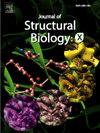Production and cryo-electron microscopy structure of an internally tagged SARS-CoV-2 spike ecto-domain construct
IF 5.1
Q2 BIOCHEMISTRY & MOLECULAR BIOLOGY
引用次数: 0
Abstract
The SARS-CoV-2 spike protein is synthesized in the endoplasmic reticulum of host cells, from where it undergoes export to the Golgi and the plasma membrane or retrieval from the Golgi to the endoplasmic reticulum. Elucidating the fundamental principles of this bidirectional secretion are pivotal to understanding virus assembly and designing the next generation of spike genetic vaccine with enhanced export properties. However, the widely used strategy of C-terminal affinity tagging of the spike cytosolic tail interferes with proper bidirectional trafficking. Hence, the structural and biophysical investigations of spike protein trafficking have been hindered by a lack of appropriate spike constructs. Here we describe a strategy for the internal tagging of the spike protein. Using sequence analyses and AlphaFold modeling, we identified a site down-stream of the signal sequence for the insertion of a twin-strep-tag, which facilitates purification of an ecto-domain construct from the extra-cellular medium of mammalian Expi293F cells. Mass spectrometry analyses show that the internal tag has minimal impact on N-glycan modifications, which are pivotal for spike-host interactions. Single particle cryo-electron microscopy reconstructions of the spike ecto-domain reveal conformational states compatible for ACE2 receptor interactions, further solidifying the feasibility of the internal tagging strategy. Collectively, these results present a substantial advance towards reagent development for the investigations of spike protein trafficking during coronavirus infection and genetic vaccination.

内部标记的SARS-CoV-2刺状结构域结构体的制备和低温电镜结构
SARS-CoV-2刺突蛋白在宿主细胞的内质网合成,从那里输出到高尔基体和质膜,或从高尔基体返回到内质网。阐明这种双向分泌的基本原理对于理解病毒组装和设计具有增强出口特性的下一代刺突基因疫苗至关重要。然而,广泛使用的穗胞质尾部c端亲和标记策略干扰了正常的双向运输。因此,由于缺乏合适的刺突结构,刺突蛋白运输的结构和生物物理研究受到阻碍。在这里,我们描述了刺突蛋白的内部标记策略。利用序列分析和AlphaFold模型,我们确定了信号序列下游的一个位置,用于插入双链标签,这有助于从哺乳动物Expi293F细胞的细胞外培养基中纯化外结构域结构体。质谱分析表明,内部标签对n -聚糖修饰的影响最小,而n -聚糖修饰是刺-宿主相互作用的关键。单粒子低温电镜重建的尖峰外位结构域揭示了与ACE2受体相互作用相容的构象状态,进一步巩固了内部标记策略的可行性。总的来说,这些结果为研究冠状病毒感染和遗传疫苗接种期间刺突蛋白运输的试剂开发提供了实质性的进展。
本文章由计算机程序翻译,如有差异,请以英文原文为准。
求助全文
约1分钟内获得全文
求助全文
来源期刊

Journal of Structural Biology: X
Biochemistry, Genetics and Molecular Biology-Structural Biology
CiteScore
6.50
自引率
0.00%
发文量
20
审稿时长
62 days
 求助内容:
求助内容: 应助结果提醒方式:
应助结果提醒方式:


